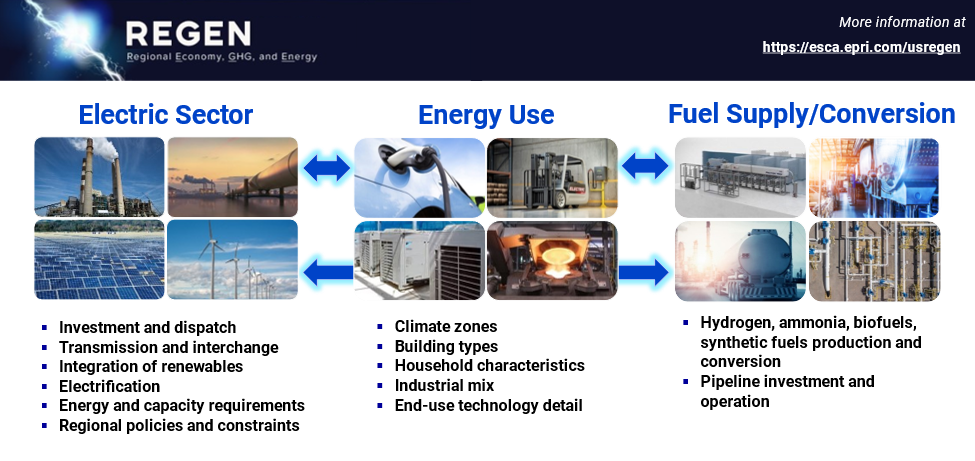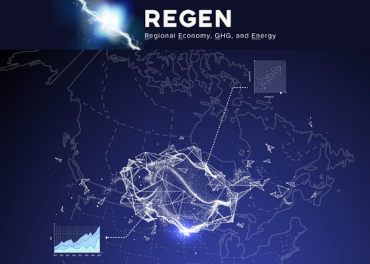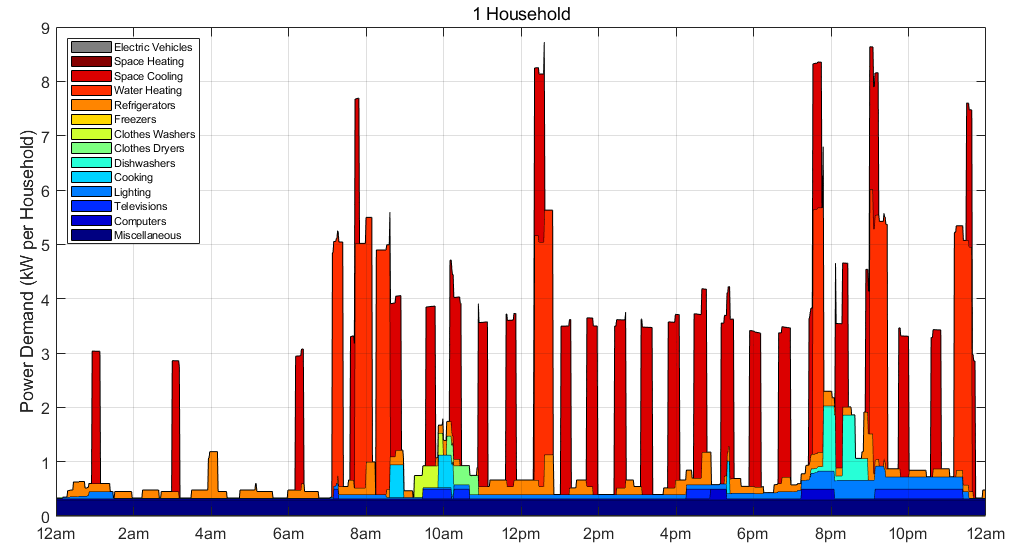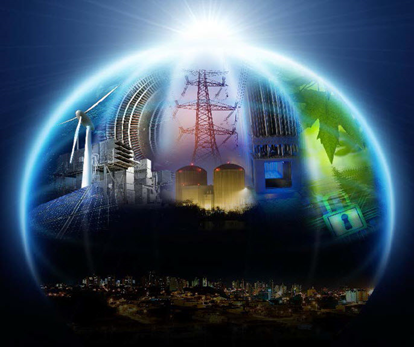Models

U.S. Regional Economy, Greenhouse Gas, and Energy (US-REGEN)

The U.S. Regional Economy, Greenhouse Gas, and Energy (US-REGEN) model is an energy-economy model developed and maintained by EPRI’s Energy Systems and Climate Analysis (ESCA) group. The model provides a customizable platform for policy analysis, technology assessment, and strategy that is informed by decades of EPRI research on energy modeling and technology analysis.
US-REGEN links a detailed electric sector capacity planning and fuels supply model with representations of demand in buildings, transport, and industry. The model jointly optimizes regional investments in electricity generation and energy storage, system dispatch, transmission, and non-electric fuels supply, which includes high temporal resolution and chronology to better characterize the economic incentives of variable renewables, energy storage, and dispatchable generation. The end-use models represent trade-offs between end-use technologies and fuels for a wide range of disaggregated sectors and activities with economy-wide coverage and include structural detail across several dimensions relevant for fuel and technology choice, such as building size, type, and vintage, climate zone and location, and vehicle ownership and driving intensity.
Download Introductory slides on REGEN (last updated in April 2025).
Access the open-source version of US-REGEN on GitHub
Current Full Documentation List
Contact:
Geoff Blanford gblanford@epri.com
John Bistline jbistline@epri.com
Nils Johnson njohnson@epri.com
Highlighted Analysis
- Climate Policy Reform Options in 2025
- Powering Data Centers: U.S. Energy System and Emissions Impacts of Growing Loads
- Impacts of EPA’s finalized power plant greenhouse gas standards
- A multi-model study to inform the United States’ 2035 NDC
- Net-Zero 2050: Sensitivity Analysis and Updated Scenarios
- Representation of Geothermal Resources and Technologies in EPRI's US-REGEN Model: Guidelines for Enhancing Geothermal Integration in Capacity Expansion Models
- LCRI Net-Zero 2050: U.S. Economy-Wide Deep Decarbonization Scenario Analysis
- The role of natural gas in reaching net-zero emissions in the electric sector | Nature Communications
- Electrification Scenarios for New York's Energy Future (epri.com)
- Air Quality Implications of an Energy Scenario for California Using High Levels of Electrification | California Energy Commission
Methodology
- Merrick, J., J. Bistline, and G. Blanford (2024). On Representation of Energy Storage in Electricity Planning Models. Energy Economics, 136: 107675.
- Analysis of Foresight in Long-Term Energy System Models, EPRI Report 3002021161, December 2021
- Bistline, J., C. Roney, D. McCollum, and G. Blanford. Deep Decarbonization Impacts on Electric Load Shapes and Peak Demand. Environmental Research Letters, 16(9):094054, October 2021.
- Bistline, J.E., G. J. Blanford, T Mai, J Merrick. Modeling Variable Renewable Energy and Storage in the Power Sector. Energy Policy. 156:112424, September 2021,
- Bistline, J.E. The Importance of Temporal Resolution in Modeling Deep Decarbonization of the Electric Power Sector. Environmental Research Letters, 16:084005, July 2021,
- Bistline, J.E. Variability in Deeply Decarbonized Electricity Systems. Environmental Science & Technology. 55:9:5629-5635. April 2021.
- Geoff Blanford, James Merrick, John Bistline, and David Young (2018): "Simulating Annual Variation in Load, Wind, and Solar by Representative Hour Selection" (The Energy Journal)
Canada Regional Economy, Greenhouse Gas, and Energy (Canada REGEN)

The Canada Regional Economy, Greenhouse Gas, and Energy (Canada REGEN) model is an energy-economy model developed by EPRI’s Energy Systems and Climate Analysis (ESCA) group. It combines a detailed capacity expansion and dispatch model of electric sector with representations of demand in buildings, transport, and industry. The model provides an integrated framework for exploring the evolutions of energy supply and demand in Canada and the United States with technological, sectoral, temporal, and spatial detail.
Download Introductory slides on REGEN (last updated in April 2025).
Contact:
Chris Roney croney@epri.com
Francisco Ralston Fonseca ralstonfonseca@epri.com
Canada REGEN Model Documentation
Highlighted Analysis
- Advanced Reactors Global Market Outlook and Economic Assessment: United States and Canada AR Economic Assessment Study
- Insights for Canadian electricity generation planning from an integrated assessment model: Should we be more cautious about hydropower cost overruns?
- Canadian National Electrification Assessment: Electrification Opportunities for Canada's Energy Future EPRI Report 3002021160, September 2021
- Canadian National Electrification Assessment: Electrification Opportunities for Canada's Energy Future (French Translation)
- Estimating Power Sector Leakage Risks and Provincial Impacts of Canadian Carbon Pricing Environmental and Resource Economics, 76, 91-118, April 2020
Model for Estimating the Regional and Global Effects of Greenhouse Gas Reductions (MERGE)
MERGE is an intertemporal general equilibrium model with a reduced-form representation of the economy, the energy sector, related emissions and concentrations of carbon dioxide and other greenhouse gases, and the climate system. It is designed to be sufficiently transparent to allow exploration of the implications of alternative viewpoints in the greenhouse debate.
Contact:
Geoff Blanford gblanford@epri.com
EPRI Reports
Links will open a PDF in a new window/tab.
| Product ID | Name | Published | Type |
|---|---|---|---|
| 1020389 | The Power to Reduce CO2 Emissions: The Full Portfolio 2009 | 26-Oct-2009 | Corporate |
| 1015461 | The Power to Reduce CO2 Emissions: The Full Portfolio Discussion Paper | 5-Sep-2007 | Corporate |
Articles / Presentations
| Name | Author | Published | Size |
|---|---|---|---|
| International Offsets: The potential role of the energy sector |
Geoff Blanford | May 2010 | 809 KB |
| Stabilization and the Energy Sector |
Geoff Blanford | May 2010 | 410 KB |
| Feasible climate targets: The roles of economic growth, coalition development and expectations |
Geoff Blanford | December 2009 | |
| Breaking the climate stalemate? |
Geoff Blanford | December 2009 | |
| The value of technological advance in decarbonizing the U.S. economy |
Rich Richels | July 2008 |
Stochastic Behavior-based Load Simulator (LoadSim)

LoadSim is used to construct highly-resolved (sub-hourly) estimates of residential demand based on assumptions around customer behavior. LoadSim employs a bottom-up modeling approach in which the characteristics of the home, its individual end-uses (appliances, lighting, etc.), and the behavior of its occupants are evaluated in tandem. Occupant behavior is modeled using data from the American Time Use Survey (ATUS) to create a statistically consistent representation of how customers interact with major residential end-uses. ATUS data is used to construct Markov chains for a variety of occupant types and defined activity categories, which are simulated using the Monte Carlo method of repeated random sampling. To estimate energy consumption, LoadSim utilizes detailed physics-based characterizations of major residential end-uses and their interactions with customers and external environmental conditions. Applications of this modeling framework include load shape estimation, distribution/secondary system design, and demand flexibility evaluation.
LoadSim is supported by EPRI's Electrification and Sustainable Energy Strategy sector and by EPRI's Energy Systems and Climate Analysis group.
Contact:
Brandon Johnson bjjohnson@epri.com
EPRI Reports
Links will open a PDF in a new window/tab.
| Product ID | Name | Published | Type |
|---|---|---|---|
| 3002018707 | Residential Behavior Based End-Use Modeling: 2020 Technology Innovation Project | 31-Dec-2020 | White Paper |
| 3002030047 | Program on Technology Innovation: Modeling Residential Demand with LoadSim | 19-Dec-2024 | White Paper |
Forestry and Agricultural Sector Optimization Model with Greenhouse Gases (FASOM-GHG) Description / Results List
The Forestry and Agricultural Sector Optimization Model with Greenhouse Gases (FASOM-GHG) is an intertemporal partial equilibrium model of the U.S. forestry and agricultural economic sectors, including biomass production for bioenergy. It is designed for detailed evaluation of potential changes in future U.S. forestry and agriculture commodity production and consumption, land management, land allocation, and greenhouse gases with respect to alternative economic, technological, biophysical, and policy scenarios.
Contact:
Steve Rose srose@epri.com
Geoff Blanford gblanford@epri.com
Articles / Presentations
| Name | Author | Published | Size |
|---|---|---|---|
| U.S. Biomass Supply for Power & Environmental Implications (Draft Results) | Steven Rose | June 2011 | 684 KB |
| Net Farm Income and Land Use under a U.S. Greenhouse Gas Cap and Trade | Geoff Blanford | April 2011 | 910 KB |
Electric Generation Expansion Analysis System
The Electric Generation Expansion Analysis System (EGEAS) is a modular state-of-the-art generation expansion software package. EGEAS is used by utility planners to produce integrated resource plans, evaluate independent power producers, develop avoided costs and environmental compliance plans, and analyze life extension alternatives. EGEAS is a set of computer modules that determine an optimum expansion plan or simulate detailed production costs for a prespecified plan. Expansion plans are defined by the type, size, and installation date for each new generating facility or demand-side management resource. Optimum expansion plans are developed in terms of annual costs, operating expenses, and carrying charges on investment. The objective is to find an integrated resource plan that meets the objective function specified by the user. The two objective functions in EGEAS include: minimizing total present worth costs and minimizing levelized annual customer rates. Click here for more information about EGEAS and how to obtain an EGEAS license from EPRI.
Contact
Nidhi Santen nsanten@epri.comEGEAS Software
| Product ID | Name | Published | Type |
|---|---|---|---|
| 3002009567 | EGEAS Version 13.1 Software | 05-Nov-2018 | Software |
EGEAS Documentation
Links will open a PDF in a new window/tab.
| Product ID | Name | Published | Type |
|---|---|---|---|
| 3002014878 | EGEAS Users Guide, Version 13.1 | 20-Nov-2018 | Technical Results |
| 3002014877 | EGEAS Capabilities Manual, Version 13.1 | 20-Nov-2018 | Technical Results |
EGEAS Presentations
TAGWeb® Energy System Technology Cost and Performance Database and Toolset

The TAGWeb® (Technical Assessment Guide Web) is an integrated, web-based software tool that provides current economic cost and technical performance data and analytical tools to assess power generation and storage technologies, including:
- Renewable power generation: Solar photovoltaic (PV), onshore wind, offshore wind, solar thermal, geothermal, and biomass.
- Energy storage technologies: Batteries (lithium ion; flow; metal air; sodium-based), compressed air energy storage, flywheels, and pumped storage hydropower.
- Fossil fuel-fired technologies: Natural gas combustion turbines (CTs) and combined cycles (CCs), pulverized coal, and coal gasification technologies, all with and without carbon capture and storage (CCS) options.
- Hydrogen Combustion: Hydrogen-fired CTs and CCs.
- Nuclear technologies: Conventional and small modular reactors (SMR).
- Distributed generation: Reciprocating internal combustion engines (RICEs), small combustion turbines, and fuel cells.
TAGWeb enables company resource planners, engineers, and strategists to identify lower-cost, environmentally-compliant power generation and storage options related to new capacity additions, plant retrofits and retirements, and major asset replacement and refurbishment. Many electric companies use TAGWeb to support development of their Integrated Resource Plans (IRPs) and screen new potential technology additions. Some electric companies also use TAGWeb to validate or benchmark cost and performance data collected internally or from third-parties.
EPRI Contacts
For information about TAGWeb, please contact Todd Gorgian tgorgian@epri.com.
TAGWeb Documentation
- TAGWeb Overview
- Technology Assessment Guide: 2022 Technology Cost and Performance Basis Update. EPRI report 3002024239, December 2022.
- TAGWeb Supplemental Project Notice. EPRI report 3002030823, April 2025.
- TAGWeb Usage Guidelines. EPRI report 3002014379, November 2018.
TAGWeb Training
Highlighted Analysis
- TAGWeb v4.0, EPRI Software 3002023481, December 2023.
- Generation Technology Options - 2024. EPRI report 3002029428, July 2024.
- 2024 Energy System Technology Cost and Performance Summary: Market Trends and Technology Insights, EPRI report 3002030846, August 2024.
- Technology Assessment Guide: Engineering Economics—Fundamentals and Methods of Electricity Supply Economic Calculations, EPRI Report 3002021216, October 2021.
